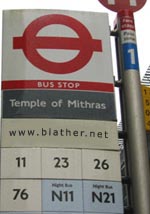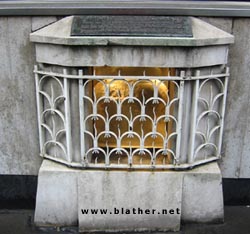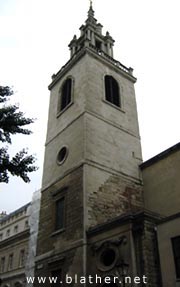Day

Back in London… A city I can appreciate on many levels, but can never quite warm to. My last visit had been in 1999 or 2000, probably for a Fortean Times UnConvention. My lightning-raid incursions tend to happen over weekends of busy intensity, so I’m perhaps unqualified to judge the place. Besides, the denizens seem to be managing quite well with out me.
London provides a home to several of my friends. Mark Pilkington, of the Strange Attractor posse, was involved in putting on Megalithomania in conjunction with Third Stone magazine, in Holborn’s Conway Hall. A delegations of the Blather Inner Circle decided to attend. So we did.
Mr. Kavanagh – Blather.net‘s Man In London – was up and gone early on Saturday morning, in order to catch John Michell’s talk and to help out. The lovely Ms. Maria Behan and myself, after coffees and cake, sailed into Conway Hall about 1200hrs, completely missing Michell’s apparently bewildering ‘Introduction to Megalithomania’ and Andy Worthington’s History of the Stonehenge Free Festivals. After catching up Flaneur Joe McNally and having blowing some quid Sterling on books, we caught some of Andy Letcher’s talk on ‘encounters with fairies by road protestors’, before availing of some urban antiquarianism by way of Rob Stephenson’s discussion of London as ‘The Legendary City’. Stephenson led us through what lies behind and below London, mixing archeology, history, prehistory and myth to paint a picture of London’s past. Stephenson, a registered London guide, knows the ancient city backwards… It’s impossible to adequately summarise the extent of his talk, such was its breadth (The following day, we joined Mr. Stephenson on walk through The City, more of which later).
We spent lunchtime in the park across the street, eating tasty Italian food, and fighting the pigeons. For a California-based academic, Leslie Ellen Jones knows a hell of a lot about obscure British TV programmes. Her lecture covered the prevalence of megaliths in movies and TV – and she was just as inclined to discuss bad, ugly films as she was the more artistically blessed. She accompanied her talk with clips from Dr Who, footage of Children of the Stones, Quatermass and the hilariously crap 1971 British movie Psychomania (in which ‘The Living Dead’, a gang of motorcycle hoodlums, seek immortality through ritual suicide in a stone circle). And that wasn’t all. As Joe McNally pointed out on the forteana mailing list, Jones was ‘the only speaker of the day to illustrate her talk with excerpts from "This is Spinal Tap"’.
The Rev. Alan Walker seems to have been a highlight for many Megalithomaniacs. Stepping up the lectern in his black clerical garb, collar and the kind of boots you wouldn’t expect to see on a clergyman, Rev. walker led us on a religious trail around London, defining the religious boundaries and precedents, from pre-Roman times to the present day.
Missing Robert Wallis, we bounced back from a coffee and cake break, we arrived two-thirds of the way through Ian Sinclair, which was marginally worse than not making it all. Sinclair was on a very particular psychogeographical groove, and we weren’t. It was urban-megathomaniacal beat poetry. Or something. Perhaps I should read his book. No matter. We had spent most of the day in the gallery, with the Ethical Society’s huge ‘To Thine Own Self Be True’ inscription glaring at us from above the stage. As the evening drew in, the skylights faded, and we found a comfortable vantage point for Paul Devereux’s talk. Paul discussed the reasoning behind ancient sites throughout the world, backed up by an impressive set of slides. He argued that many of these sites are located where there are due to significant physical landmarks. In some cases, the builders were drawn to the sites by the natural simulacra (e.g. giant faces on mountainsides) around them. In others, the megaliths themselves mimic mountains of spiritual importance, or other natural landmarks.
Night
The conference dissolved for dinner – the speaking was over, the music was next. On our arrival at Conway Hall, we were first subjected to some 111Hz noise – apparently a frequency found to be conducive to trance-like states, while watching a documentary about the view of the rising sun at Loughcrew, a megalithic site here in Ireland. Worked for me – I had been complaining of tiredness beforehand, but 10 minutes of 111Hz woke me up. According to some research by Devereux and others, standing waves have been achieved in several ancient sites – Newgrange and Loughcrew included – at a frequency of 110-112Hz.
Next up were the folkish melodies of two bands, Wigwam and Gorodisch. The talents of the musicians in the former hinted at greater things – but the voice of the main singer was distinctly normal and unengaging. Gorodisch didn’t impress me much until they did the ‘Gently Johnny’ number from The Wicker Man.
I wish I had paid more attention to Mount Vernon Astral Laboratory. Instead, I wandered off to the bar. When I returned, it was to a cacaphony that sounded like a bunch of evil sperm whales planning world domination, recorded on a reel-to-reel via an air-conditioning system. Coupled with an eerie slide show of stark, ruined military citadels, disused nuclear installations and industrial units, the show provided a cold, clear edginess.
The evening was brought to a close by Coil, who started off well. Backdropped by trippy animations of water drops breaking the surface of calm water, they crawled around in white ‘forensic’ suits with compact disc pendants, Teletubbie style. Either side of them were stationary figures in black, in outfits very reminiscent of Spanish Semana Santa costumes, complete with cone-shaped headgear. The music roared, with a tense nervousness. Coil seem to be as much about performance as music – they threw very definite shapes on stage, rolling about… very slowly.
After an age, the coneheaded figures moved. Slowly… Front man John Balance vanished back stage, and came back with what appeared to be a cuddly rabbit, which he proceeded to flagellate himself with. At some point – and this is where it gets vague, everyone has a different version – Balance jumped off the stage, and beat the rabbit to a bloody pulp. Some people apparently thought it to be a real bunny. He threw some water on the audience, beer was thrown back. Some gangly bloke in dreads sprinted forth from a corner of the gallery, flung a beer can towards the stage. It cracked some innocent bystander on the head. The angry young man (with a beer in his hand) made his apologies, slunk back to his seat, defeated. Balance shouted into the microphone some more. And it was over. While I appreciated having seen Coil, and having enjoyed the first 1/3 of their set, I wish they hadn’t done effectively the same thing for the other 2/3. I felt it lacked depth…

St. Paul’s Cathedral
THE AFTERMATH
The next morning, we dragged ourselves into the City, to meet a crowd of Megalithomanics on the steps of St. Pauls Cathedral. Saturday’s speaker Rob Stephenson led us off into a sneak preview of the London Before London exhibition in the City of London Museum. Workmen were still finishing the lighting as we passed by cases of lion, mammoth and hippo bones, ancient tools and human remains and other artefacts leading up to Roman times.

The Temple of Mithras
A quick dash around some of the rest of the museum took in artefacts from the Temple of Mithras, which was a temple dedicated to the Persian Sun God, discovered in the Walbrook area of the City, after World War II.

The London Stone
After we left the museum, Rob Stephenson led us, in pissing rain, around some interesting sites – the Temple of Mithras itself, in its new location, Sir Christopher Wren’s St. Stephen Walbrook – the temple’s original location…the London Stone, stuck in the wall of a financial company’s office, through the ruins of the Church of St. Mary, Aldermanbury, also designed by Wren in 1667, destroyed in the Blitz in 1940, and subsequently rebuilt in Fulton, Missouri… we saw churches by Hawksmoor and more by Wren, and the Guildhall, built more or less on top of the original Roman amphitheatre.

St. Stephen Walbrook Church
HOME
I left via the City Airport on a grey wet October evening, my attitude towards London changed slightly . I had gained a sense of what lay beneath the pavement, of a truly ancient city. While Dublin has been a city for one millennium, it doesn’t have the ancient high culture of London’s past.
Notes:
Strange Attractor
Third Stone magazine
Megalithomania site
Conway Hall
John Michell
Joe McNally, Flaneur
Andy Letcher – ‘Virtual paganism’ or direct action? The implications of road protesting for modern paganism
Rob Stephenson – London Earth Mysteries Circle
Leslie Ellen Jones – Druid Shaman Priest review
Ian Sinclair
Paul Devereux
Mount Vernon Arts Lab
Coil
Church of St. Mary, Aldermanbury
Temple of Mithras (Britain Express)
Temple of Mithras (Museum of Antiquities, Newcastle University)
London Stone
Museum of London
